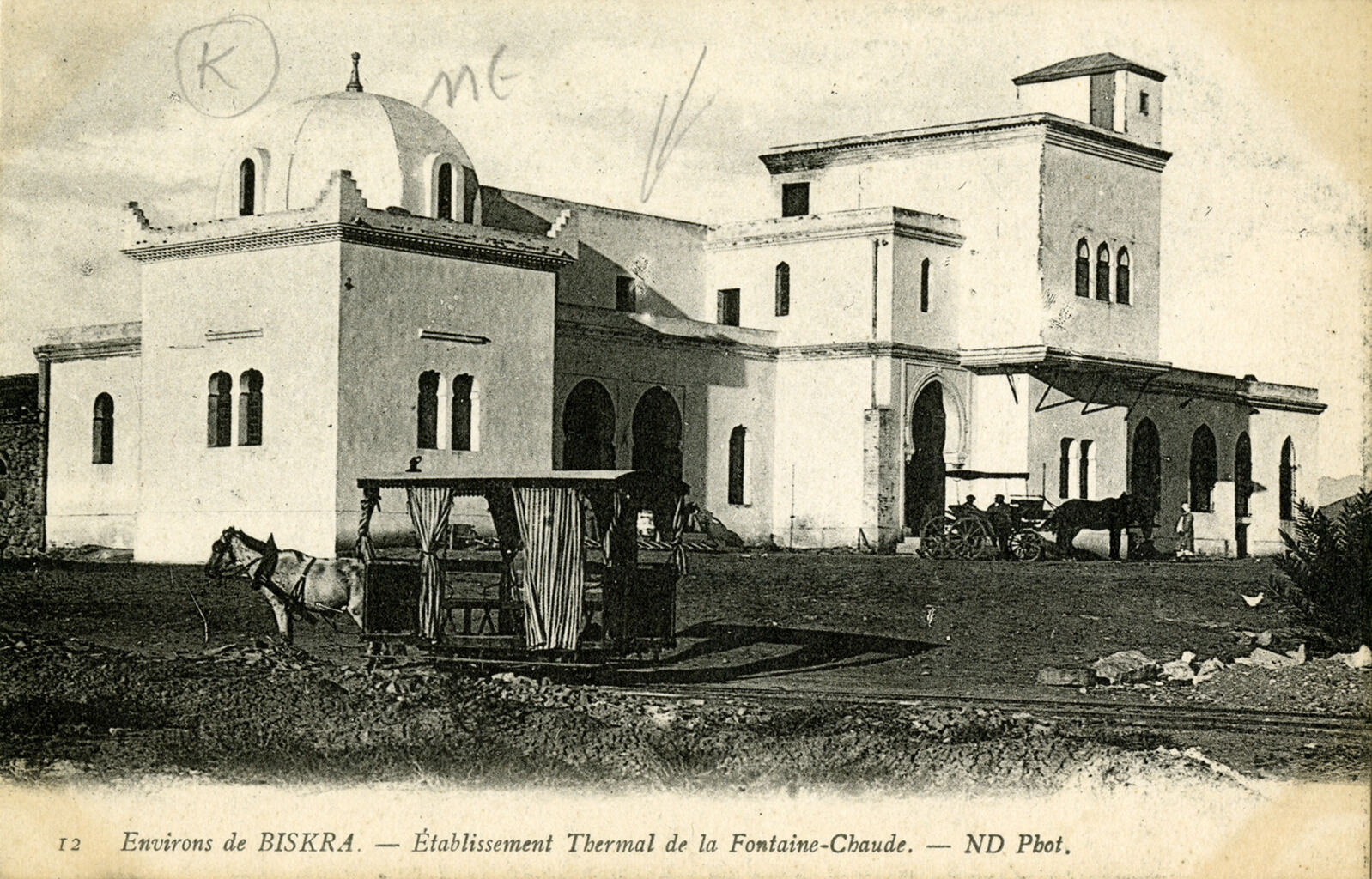![]()
Christian Adolf Schreyer, Algerian Horsemen near an Oasis (possibly Biskra), ca. 1863
| Artist | Christian Adolf Schreyer, German, 1828–99 |
| Title | Algerian Horsemen near an Oasis (possibly Biskra) |
| Object Date | ca. 1863 |
| Alternate and Variant Titles | Arab Horsemen; The Oasis; Tunisian Arabs on Horseback |
| Medium | Oil on canvas |
| Dimensions (Unframed) | 24 x 29 in. (61 x 73.7 cm) |
| Signature | Signed lower left: ad Schreŷer |
| Credit Line | The Nelson-Atkins Museum of Art. Purchase: William Rockhill Nelson Trust, 32-10 |
Catalogue Entry
Citation
Chicago:
Glynnis Napier Stevenson, “Christian Adolf Schreyer, Algerian Horsemen near an Oasis (possibly Biskra), ca. 1863,” catalogue entry in French Paintings and Pastels, 1600–1945: The Collections of The Nelson-Atkins Museum of Art, ed. Aimee Marcereau DeGalan (Kansas City: The Nelson-Atkins Museum of Art, 2022), https://doi.org/10.37764/78973.5.418.5407.
MLA:
Stevenson, Glynnis Napier. “Christian Adolf Schreyer, Algerian Horsemen near an Oasis (possibly Biskra), ca. 1863,” catalogue entry. French Paintings and Pastels, 1600–1945: The Collections of The Nelson-Atkins Museum of Art, edited by Aimee Marcereau DeGalan, Nelson-Atkins Museum of Art, 2022. doi: 10.37764/78973.5.418.5407.
Born in Frankfurt-am-Main in 1828, Christian Adolf Schreyer traveled widely in search of exotic locales to paint. His canvases, inspired by the snowy plains of Eastern Europe and the deserts of North Africa, won medals at three Paris SalonsSalon, the: Exhibitions organized by the French Royal Academy of Painting and Sculpture (Académie Royale de Peinture et de Sculpture) and its successor the Academy of Fine Arts (Académie des Beaux Arts), which took place in Paris from 1667 onward., and wealthy American collectors sought them out.1Chauncey Mitchell Depew Jr. (1879–1931), the son of a senator from New York, probably owned the Nelson-Atkins picture just before the museum purchased it in 1932. After studying at Frankfurt’s Städel Institut, Schreyer served as a painter-reporter for the German regiment of Maximilian Karl (1802–71), 6th Prince of Thurn und Taxis, during the Crimean War (1854–57). A decade after his wartime experience, Schreyer enthralled Parisian audiences with immersive battle scenes hailed as “the work of a master.”2Le Salon de 1865 (Lyon, France: L. Perrin, 1865), 17. Translations are by the author unless otherwise noted. At the Salon of 1865, Schreyer earned a medal for The Charge of the Artillery of the Imperial Guard, Traktir, Crimea, 16 August 1855 (Fig. 1), purchased by the French State after the Salon and now in the collection of the Musée d’Orsay. This painting displays all the trademarks of Schreyer’s work: proximity to the action, attention to the details of uniforms and anatomy, and empathy for the trauma experienced by warhorses. Schreyer’s depiction of horse anatomy is so precise that the Nelson-Atkins picture, which is contemporaneous to The Charge of the Artillery, was recently used as an illustration in a study on horse genetics.3William M. Hudson Jr., Matrilines of the Egyptian Arabian Horse, 2 vols. (Cumming, GA: Hudson Cardiology, 2018).
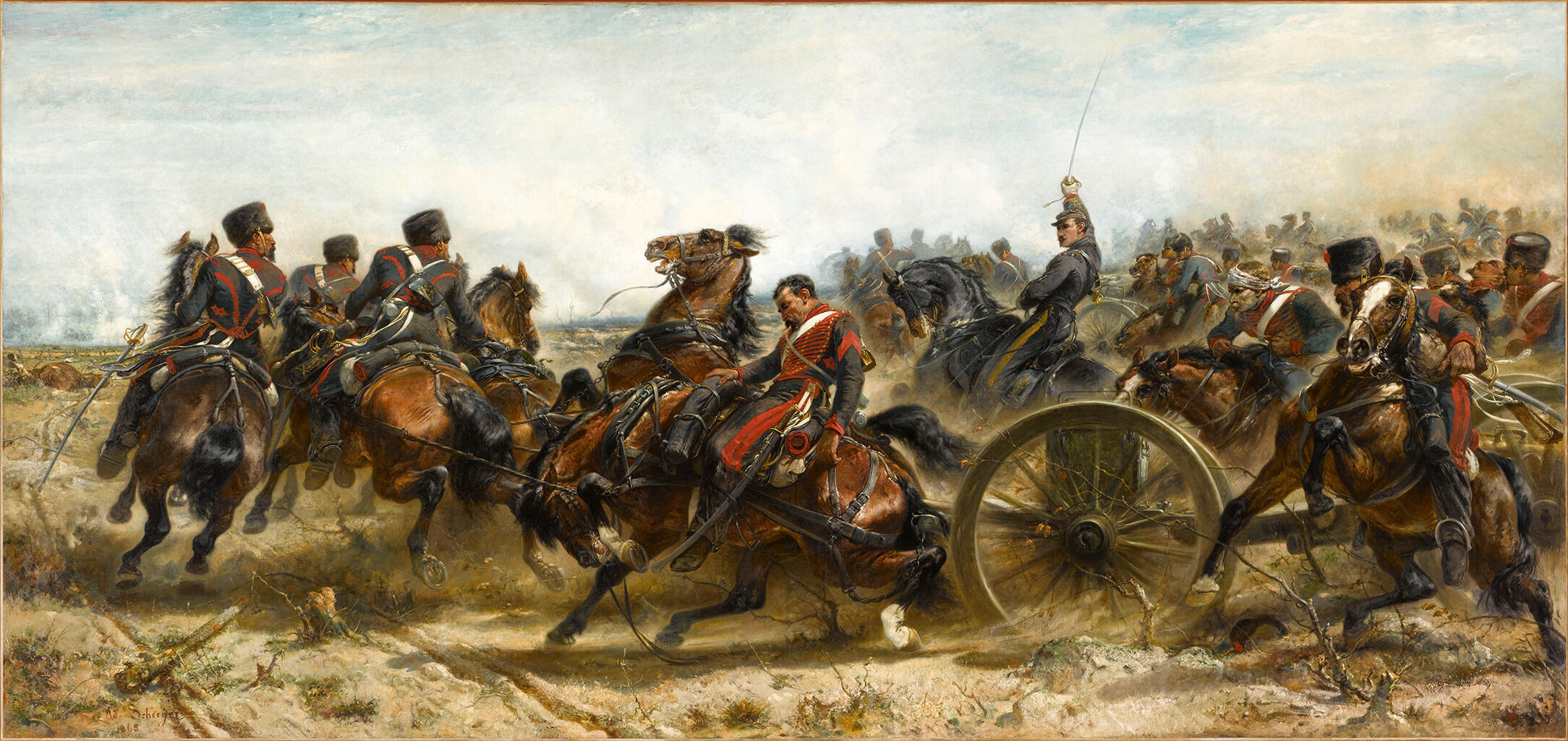
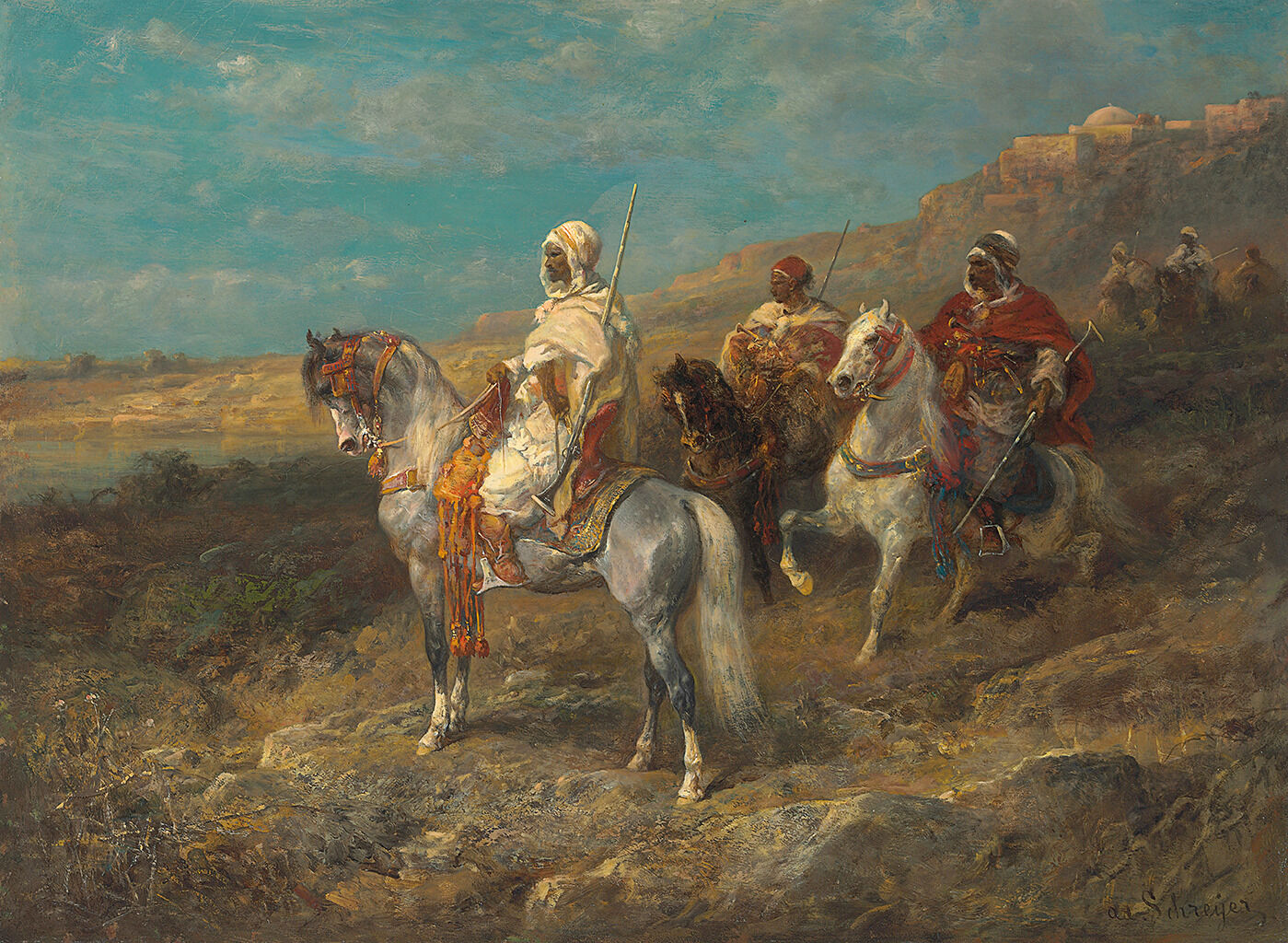
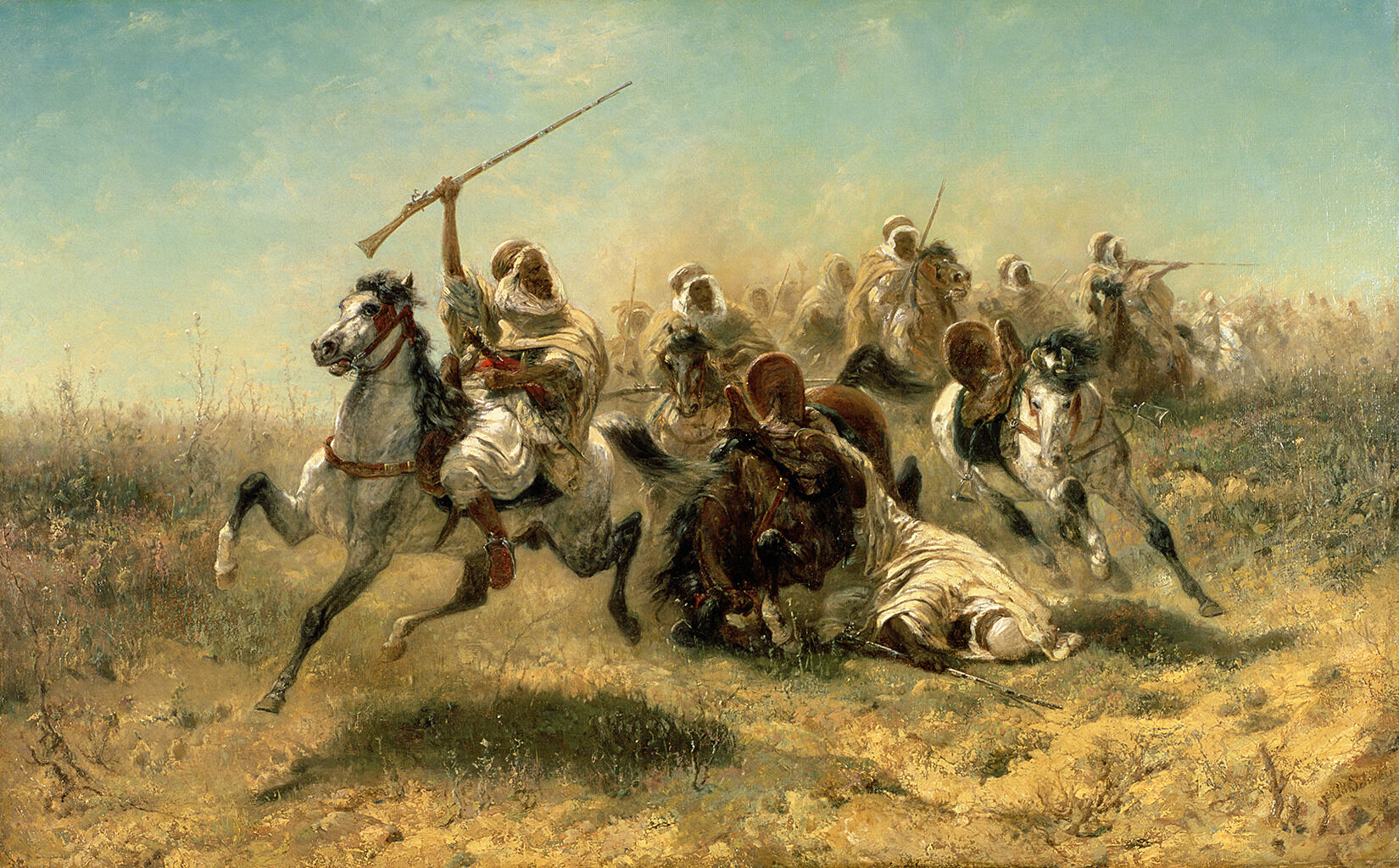
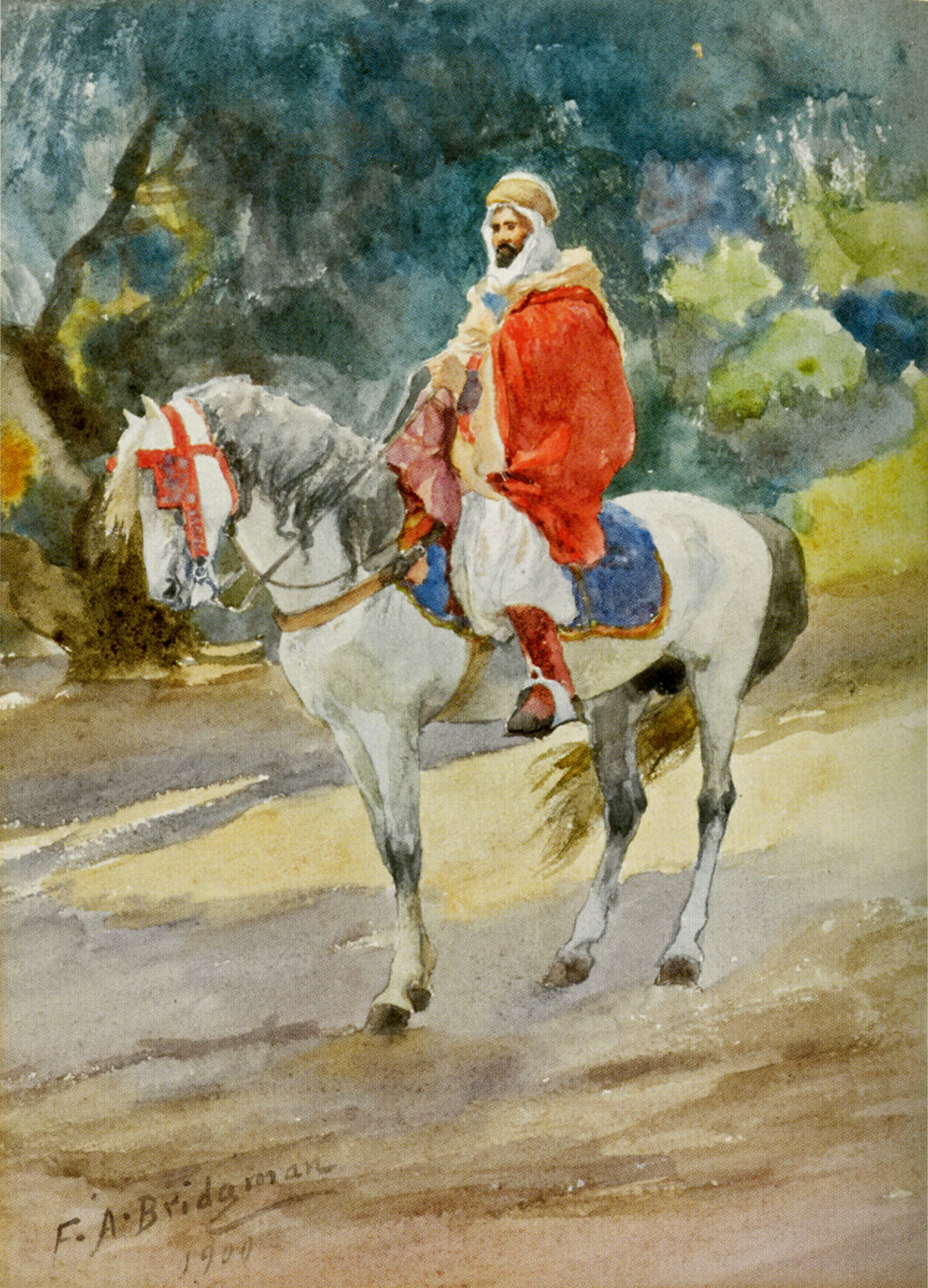
The historical title of the Nelson-Atkins picture, The Oasis, is the first clue to determining where Schreyer traveled.14See Important Paintings by Schreyer, Heuner, Daubigny, Dessar, Murphy, Van Goyen, Gainsborough, Lobley, Van Huysam and Artists of Like Distinction from Several Collections together with an Atheneum Portrait of Washington, by Stuart, and a Portrait of Judge Robert Johnson, by Waldo from the Estate of the Late Chauncey M. Depew, Jr., O’Reilly’s Plaza Art Galleries, New York, December 4, 1931, lot 11, as The Oasis. One of his other pictures, Arab at a Fountain in Bouchagroune (Algérie) (location of painting unknown), includes the name of a town in Biskra Province, a region encircling the oasis of Biskra.15Schreyer gave this painting to the artist François Bonvin, who then lost his livelihood when he became blind and paralyzed. Bonvin sold his collection at Hôtel Drouot on May 9–10, 1887, to support himself. Catalogue de tableaux, aquarelles, dessins, sculptures, etc.; Offerts par les artistes a [sic] F. Bonvin, leur confrère frappe de cécité et de paralysie (Paris: Hôtel Drouot, May 9–10, 1887). The quickest route to Biskra at the time was a steamer ship from Marseille to the Algerian port of Skikda (renamed Philippeville in 1838 by the French colonial administration, in honor of King Louis-Philippe). From Skikda to Biskra was an additional two-hundred-mile overland journey, for a total of approximately three days’ travel from Paris.16In Alfred E. Pease’s travel guide of 1893, he writes that European travelers in the Maghreb should take the train to reach Biskra from a variety of places, including Algiers and El Kantara. Alfred E. Pease, Biskra and the Oases and Desert of the Zibans with Information for Travellers (London: Edward Stanford, 1893), 9. When Schreyer traveled there in 1861, Algeria was not yet fully under French control, and it is unclear if his journey would have been smooth. For the first forty years of French occupation, French Algeria was a military state.17Patricia M. E. Lorcin, “Imperialism, Colonial Identity, and Race in Algeria, 1830–70: The Role of the French Medical Corps,” Isis 90, no. 4 (December 1999): 655. On March 14, 1844, Henri d’Orléans (1822–97), Duke of Aumale and King Louis-Philippe’s son, besieged Biskra with three thousand French troops and installed the Ben Ganah family as leaders of the city in return for their assistance to the French Army.18Benjamin Claude Brower, A Desert Named Peace: The Violence of France’s Empire in the Algerian Sahara, 1844–1902 (New York: Columbia University Press, 2009), 29. While the French boasted that they had captured Biskra without firing a shot, there was a mutiny among the Indigenous mercenaries less than two months later.19Brower, A Desert Named Peace, 40. Resistance to French rule was persistent, and the garrison at Biskra required five hundred permanent French soldiers just to maintain their foothold in the North African desert.20Brower, A Desert Named Peace, 41.
Once a darling of America’s most prominent collectors, Schreyer is scarcely mentioned in the vast body of modern scholarship on Orientalist painting. As the Nelson-Atkins picture shows, his depiction of Algerian spahis provides rare, early insight into the French colonial military state, whereas most other images of Biskra date from later in the century, when the city became a tourist destination. A recent exhibition at the Arab Institute in Paris highlighted Biskra’s burgeoning tourist industry beginning in the 1880s, assembling images of bazaars, fantasized harems, and photographs of other local sites as seen through European eyes.24Roger Benjamin, Biskra: Sortilèges d’une oasis, exh. cat. (Paris: l’Institut du monde arabe, 2016). Most famously, Henri Matisse’s Nu bleu (Souvenir de Biskra) / Blue Nude (Memory of Biskra) (1907; Baltimore Museum of Art) presented the Maghreb as a region that was easily accessible to Europeans in every sense. Schreyer’s paintings are a preamble to the development of Algeria as a tourist destination for Europeans. His depictions of spahis performing reconnaissance tasks at the mouth of the Sahara are crucial to a full understanding of the French imperial project in North Africa.
Notes
-
Chauncey Mitchell Depew Jr. (1879–1931), the son of a senator from New York, probably owned the Nelson-Atkins picture just before the museum purchased it in 1932.
-
Le Salon de 1865 (Lyon, France: L. Perrin, 1865), 17. Translations are by the author unless otherwise noted.
-
William M. Hudson Jr., Matrilines of the Egyptian Arabian Horse, 2 vols. (Cumming, GA: Hudson Cardiology, 2018).
-
The Metropolitan Museum of Art holds a letter from Schreyer to the New York dealer Samuel P. Avery dated to 1879. The only painting referenced in it is one of Schreyer’s Eastern European scenes, Wallachwagen, Sonneneffect, April 1874, 37 13/16 x 22 in. (96 x 56 cm), which sold for six thousand francs. Christian Adolf Schreyer to Samuel P. Avery, June 20, 1879, “European Letters: Samuel Putnam Avery Papers,” Thomas J. Watson Library, The Metropolitan Museum of Art, New York, https://libmma.contentdm.oclc.org/digital/ collection/p15324coll13/id/14805. Beyond this letter, there are no existing records of Schreyer’s words.
-
Schreyer has only received one retrospective in the United States, a 1972 exhibition at the Paine Art Center in Oshkosh, Wisconsin. Edmund B. Nielsen curated the exhibition and compiled a much-needed but incomplete catalogue raisonné of Schreyer’s paintings: Adolf Schreyer: An International Exhibition Presented by the Paine Art Center and Arboretum, exh. cat. (Oshkosh, WI: Paine Art Center and Arboretum, 1972). Even within Schreyer’s home country, there has been only one monographic exhibition, Adolf Schreyer (1828–1899), held in 1999 in Kronberg im Taunus, where Schreyer died in 1899.
-
Berbers are one of the Indigenous groups of the Maghreb (North Africa). The more apt description of the men depicted in Schreyer’s picture is “Arab Berbers,” since there was significant intermarriage between Berbers and Arabs following the spread of Islam via the armies of the Prophet Muhammad to North Africa beginning in 652 ᴄᴇ. In modern-day Algeria, 99 percent of the population identifies as Arab Berbers, and the majority language is Arabic. “Algeria,” CIAWorldFactbook.gov (accessed November 5, 2019), https://web.archive.org/web/20070612211925/ https://www.cia.gov/ library/publications/the-world-factbook/geos/ag.html.
-
“Le poste avancé de spahis” (“The outpost of spahis”); “un spahis, monté sur un cheval gris ardoise” (“a spahi mounted on a slate-gray horse”); “monté sur un cheval al zan” (“mounted on a chestnut horse.”) “Salon de 1863,” Le Temps, no. 208 (July 12, 1863): 1.
-
19th Century European Art and Orientalist Art (New York: Christie’s, October 22, 2008), lot 4, as Arabischer Schimmelreiter. The painting was in the J. P. Schneider collection in Frankfurt as of 1984 and later with Galerie Bühler in Munich. In this essay, I make the first identification of the 1863 picture as the one sold at Christie’s in 2008.
-
Driss Maghraoui, “From ‘Tribal Anarchy’ to ‘Military Order’: The Moroccan Troops in the Context of Colonial Morocco,” Oriente Moderno (2004): 230.
-
Derived from the Berber word abernus, the burnous is the traditional dress in the Maghreb. Made of heavy wool, a burnous is usually white. Wolfgang Bruhn and Maurice Cottaz, Encyclopédie du costume: Des peuples de l’Antiquité à nos jours ainsi que (Paris: Nouvelles editions latines, 1990), 80.
-
Maghraoui, “From ‘Tribal Anarchy’ to ‘Military Order,’” 228.
-
Colette, Le maison de Claudine (Paris: Ferenczi, 1922), 125.
-
Colette’s own father, Captain Jules-Joseph Colette, served in the Zouave regiment in North Africa. She noted that his military journals were eerily blank. She surmised that he was ambivalent about his military service and, in her short story, he is the model for the amputated father figure. Sage Goellner, “Algeria in France: Colette’s ‘Le manteaux de spahi,’” French Review 65, no. 3 (February 2012): 483, 486.
-
See Important Paintings by Schreyer, Heuner, Daubigny, Dessar, Murphy, Van Goyen, Gainsborough, Lobley, Van Huysam and Artists of Like Distinction from Several Collections together with an Atheneum Portrait of Washington, by Stuart, and a Portrait of Judge Robert Johnson, by Waldo from the Estate of the Late Chauncey M. Depew, Jr., O’Reilly’s Plaza Art Galleries, New York, December 4, 1931, lot 11, as The Oasis.
-
Schreyer gave this painting to the artist François Bonvin, who then lost his livelihood when he became blind and paralyzed. Bonvin sold his collection at Hôtel Drouot on May 9–10, 1887, to support himself. Catalogue de tableaux, aquarelles, dessins, sculptures, etc.; Offerts par les artistes a [sic] F. Bonvin, leur confrère frappe de cécité et de paralysie (Paris: Hôtel Drouot, May 9–10, 1887).
-
In Alfred E. Pease’s travel guide of 1893, he writes that European travelers in the Maghreb could take the train to reach Biskra from a variety of places, including Algiers and El Kantara. Alfred E. Pease, Biskra and the Oases and Desert of the Zibans with Information for Travellers (London: Edward Stanford, 1893), 9.
-
Patricia M. E. Lorcin, “Imperialism, Colonial Identity, and Race in Algeria, 1830–1870: The Role of the French Medical Corps,” Isis 90, no. 4 (December 1999): 655.
-
Benjamin Claude Brower, A Desert Named Peace: The Violence of France’s Empire in the Algerian Sahara, 1844–1902 (New York: Columbia University Press, 2009), 29.
-
Brower, A Desert Named Peace, 40.
-
Brower, A Desert Named Peace, 41.
-
Pease, Biskra and the Oases and Desert of the Zibans, 35.
-
Major F. W. Begbie, “A Holiday Trip in Algeria,” Journal of the Royal Army Medical Corps 7 (January 1906): 291.
-
Al-Muqaddasī cited and translated from Arabic to French in Mohamed Meouak, Les Ziban entre Aurès et Sahara: Une géographie historique de Biskra et des ses oasis du Moyen Âge à la fin de l’époque moderne (Helsinki: Academia Scientiarum Fennica, 2017), 154.
-
Roger Benjamin, Biskra: Sortilèges d’une oasis, exh. cat. (Paris: l’Institut du monde arabe, 2016).
Technical Entry
Technical entry forthcoming.
Documentation
Citation
Chicago:
Glynnis Napier Stevenson, “Christian Adolf Schreyer, Algerian Horsemen near an Oasis (possibly Biskra), ca. 1863,” documentation in French Paintings and Pastels, 1600–1945: The Collections of The Nelson-Atkins Museum of Art, ed. Aimee Marcereau DeGalan (Kansas City: The Nelson-Atkins Museum of Art, 2022), https://doi.org/10.37764/78973.5.418.4033.
MLA:
Stevenson, Glynnis Napier. “Christian Adolf Schreyer, Algerian Horsemen near an Oasis (possibly Biskra), ca. 1863,” documentation. French Paintings and Pastels, 1600–1945: The Collections of The Nelson-Atkins Museum of Art, edited by Aimee Marcereau DeGalan, Nelson-Atkins Museum of Art, 2022. doi: 10.37764/78973.5.418.4033.
Provenance
Citation
Chicago:
Glynnis Napier Stevenson, “Christian Adolf Schreyer, Algerian Horsemen near an Oasis (possibly Biskra), ca. 1863,” documentation in French Paintings and Pastels, 1600–1945: The Collections of The Nelson-Atkins Museum of Art, ed. Aimee Marcereau DeGalan (Kansas City: The Nelson-Atkins Museum of Art, 2022), https://doi.org/10.37764/78973.5.418.4033.
MLA:
Stevenson, Glynnis Napier. “Christian Adolf Schreyer, Algerian Horsemen near an Oasis (possibly Biskra), ca. 1863,” documentation. French Paintings and Pastels, 1600–1945: The Collections of The Nelson-Atkins Museum of Art, edited by Aimee Marcereau DeGalan, Nelson-Atkins Museum of Art, 2022. doi: 10.37764/78973.5.418.4033.
Possibly with Deforge-Carpentier, Paris, at the earliest by 1871–no later than 1879 [1];
Probably Chauncey Mitchell Depew, Jr. (1879–1931), New York, by January 26, 1931;
Purchased from Important Paintings by Schreyer, Heuner, Daubigny, Dessar, Murphy, Van Goyen, Gainsborough, Lobley, Van Huysam and Artists of Like Distinction from Several Collections together with an Atheneum Portrait of Washington, by Stuart, and a Portrait of Judge Robert Johnson, by Waldo from the Estate of the Late Chauncey M. Depew, Jr., O’Reilly’s Plaza Art Galleries, New York, December 4, 1931, lot 11, as The Oasis, probably by Newhouse Galleries, New York, 1931–March 25, 1932 [2];
Purchased from Newhouse Galleries, through Harold Woodbury Parsons, by The Nelson-Atkins Museum of Art, Kansas City, MO, 1932 [3].
Notes
[1] A canvas supplier mark on the verso reads, “DEFORGE-CARPENTIER / 6 / R. HALEVY”. Deforge-Carpentier supplied artists like Schreyer and Pierre-Auguste Renoir with paints and canvases, while also displaying their paintings in the shop window. John House, Pierre-Auguste Renoir: La Promenade (Los Angeles: Getty Publications 1997), 20. Deforge-Carpentier moved their shop to 6 rue Halevy, Paris in 1871, while their workshop remained at 79 rue Legendre. The firm closed in 1879.
[2] It is likely that the picture belonged to Chauncey M. Depew Jr., but the sale had multiple consignors.
[3] The painting was placed on view at the Kansas City Art Institute from March 14 until May 20, 1932, since the museum was not yet built. See “Objects owned by the W. R. Nelson Trust on exhibit at the K.C. Art Institute as of March 14, 1932,” March 14, 1932, Nelson-Atkins Archives, William Rockhill Nelson Trust Office Records 1926–33, RG 80/05, Series I, box 02, folder 17, Exhibition at the Kansas City Art Institute, 1932, and was removed before May 20, 1932. See also, “Pictures remaining in the Art Institute after May 20, 1932,” May 20, 1932, Nelson-Atkins Archives, William Rockhill Nelson Trust Office Records 1926–33, RG 80/05, Series I, box 02, folder 17, Exhibition at the Kansas City Art Institute, 1932.
Related Works
Citation
Chicago:
Glynnis Napier Stevenson, “Christian Adolf Schreyer, Algerian Horsemen near an Oasis (possibly Biskra), ca. 1863,” documentation in French Paintings and Pastels, 1600–1945: The Collections of The Nelson-Atkins Museum of Art, ed. Aimee Marcereau DeGalan (Kansas City: The Nelson-Atkins Museum of Art, 2022), https://doi.org/10.37764/78973.5.418.4033.
MLA:
Stevenson, Glynnis Napier. “Christian Adolf Schreyer, Algerian Horsemen near an Oasis (possibly Biskra), ca. 1863,” documentation. French Paintings and Pastels, 1600–1945: The Collections of The Nelson-Atkins Museum of Art, edited by Aimee Marcereau DeGalan, Nelson-Atkins Museum of Art, 2022. doi: 10.37764/78973.5.418.4033.
Christian Adolf Schreyer, Arab Caravan, ca. 1860, oil on canvas, 18 x 32 in. (45.7 x 81.3 cm), The Dayton Art Institute, OH. Gift of Mr. Robert Badenhop, 1953.64.
Christian Adolf Schreyer, Arabischer Schimmelreiter (Arab Riding a White Horse), 1863, oil on canvas, 21 1/2 x 29 in. (54.6 x 73.7 cm), sold at 19th Century European Art and Orientalist Art, Christie’s, New York, October 22, 2008, lot 4.
Christian Adolf Schreyer, Arabs on the March, before 1887, oil on canvas, 22 5/8 x 37 3/4 in. (57.5 x 95.9 cm), The Metropolitan Museum of Art, New York. Catharine Lorillard Wolfe Collection, Bequest of Catharine Lorillard Wolfe, 87.15.127.
Christian Adolf Schreyer, Arabs on Horseback, late 19th century, oil on canvas, 24 2/5 x 38 1/5 in. (62 x 97 cm), Princeton University Art Museum, NJ, 1999-35.
Christian Adolf Schreyer, Arabs, late 19th century, oil on canvas, 21 x 34 in. (53.3 x 86.4 cm), Saint Louis Art Museum. Bequest of Cora Liggett Fowler, The John Fowler Memorial Collection, 169:1928.
Christian Adolf Schreyer, The Oasis, late 19th century, oil on canvas, 16 x 25 in. (40.6 x 63.5 cm), private collection.
Exhibitions
Citation
Chicago:
Glynnis Napier Stevenson, “Christian Adolf Schreyer, Algerian Horsemen near an Oasis (possibly Biskra), ca. 1863,” documentation in French Paintings and Pastels, 1600–1945: The Collections of The Nelson-Atkins Museum of Art, ed. Aimee Marcereau DeGalan (Kansas City: The Nelson-Atkins Museum of Art, 2022), https://doi.org/10.37764/78973.5.418.4033.
MLA:
Stevenson, Glynnis Napier. “Christian Adolf Schreyer, Algerian Horsemen near an Oasis (possibly Biskra), ca. 1863,” documentation. French Paintings and Pastels, 1600–1945: The Collections of The Nelson-Atkins Museum of Art, edited by Aimee Marcereau DeGalan, Nelson-Atkins Museum of Art, 2022. doi: 10.37764/78973.5.418.4033.
Kansas State Teachers College, Emporia, KS, October–November 1941.
Objects from the Collection of the William Rockhill Nelson Gallery of Art and Mary Atkins Museum of Fine Arts, Winfield High School, KS, 1946.
Adolf Schreyer: An International Exhibition Presented by the Paine Art Center and Arboretum, Paine Art Center and Arboretum, Oshkosh, WI, June 8–July 30, 1972, unnumbered, as The Oasis.
References
Citation
Chicago:
Glynnis Napier Stevenson, “Christian Adolf Schreyer, Algerian Horsemen near an Oasis (possibly Biskra), ca. 1863,” documentation in French Paintings and Pastels, 1600–1945: The Collections of The Nelson-Atkins Museum of Art, ed. Aimee Marcereau DeGalan (Kansas City: The Nelson-Atkins Museum of Art, 2022), https://doi.org/10.37764/78973.5.418.4033.
MLA:
Stevenson, Glynnis Napier. “Christian Adolf Schreyer, Algerian Horsemen near an Oasis (possibly Biskra), ca. 1863,” documentation. French Paintings and Pastels, 1600–1945: The Collections of The Nelson-Atkins Museum of Art, edited by Aimee Marcereau DeGalan, Nelson-Atkins Museum of Art, 2022. doi: 10.37764/78973.5.418.4033.
“Recently Found Washington Portrait by Stuart to Be Sold,” Art News 30, no. 9 (November 28, 1931): 18.
“Hooper and Clarke Furniture on Sale; Large Collections With Many Rare Pieces to Be Dispersed at Auction This Week; Stuart Portrait Offered; Clarke Library Is Also Included—Ten Rooms of Old King Hooper House Cover Three Centuries,” New York Times 81, no. 26,972 (November 29, 1931): 6N.
Catalogue of Important Paintings by Schreyer, Heuner, Daubigny, Dessar, Murphy, Van Goyen, Gainsborough, Lobley, Van Huysam and Artists of Like Distinction from Several Collections together with an Atheneum Portrait of Washington, by Stuart, and a Portrait of Judge Robert Johnson, by Waldo from the Estate of the Late Chauncey M. Depew, Jr. (New York: Plaza Art Galleries, December 4, 1931), 9, as The Oasis.
M[inna] K. P[owell], “A New Nelson Group: Paintings and Drawings Are Added to Gallery; The Public May View the Recent Purchases From 2 Until 6 O’Clock This Afternoon at Epperson Room,” Kansas City Star 52, no. 206 (April 10, 1932): 11A.
M[inna] K. P[owell], “Art: Mr. Parsons Will Be Heard Thursday Night on ‘The Italian Renaissance’—What Is to Be Seen in the Group of Recently Acquired Paintings for the William Rockhill Nelson Gallery of Art Was Told the Hospitality Committee Yesterday by Him,” Kansas City Times 95, no. 88 (April 12, 1932): 10, erroneously as Tunisian Arabs on horseback.
“Kansas City Adds Important Works to its Holdings: Works Recently Bought for the William Rockhill Nelson Trust All Secured from Leading New York Dealers,” Art News 30, no. 30 (April 23, 1932): 8.
“Kansas City Art Museum Adds Important Pictures to Collection,” Art Digest 6, no. 15 (May 1, 1932): 4, as The Oasis.
Art News 30, no. 36 (June 4, 1932): 15, (repro.), as The Oasis.
“The Acquisitions,” in “The William Rockhill Nelson Gallery of Art, Kansas City Special Number,” Art Digest 8, no. 5 (December 1, 1933): 22, as The Oasis.
The William Rockhill Nelson Gallery of Art and Mary Atkins Museum of Fine Arts, Handbook of the William Rockhill Nelson Gallery of Art (Kansas City, MO: William Rockhill Nelson Gallery of Art and Mary Atkins Museum of Fine Arts, 1933), 52, as The Oasis.
A. J. Philpott, “Kansas City Now in Art Center Class: Nelson Gallery, Just Opened, Contains Remarkable Collection of Paintings, Both Foreign and American,” Boston Sunday Globe 125, no. 14 (January 14, 1934): 16.
“Art and Artists: ‘Masterpiece of Week’ On Display Next Sunday; Plan to Give a Single Work of Art a Spotlight and Special Setting Each Week at the Nelson Gallery to Be Inaugurated Sunday,” Kansas City Star 54, no. 173 (March 9, 1934): 15, as Arab Horsemen.
Hans Vollmer, ed., Allgemeines Lexikon der Bildenden Künstler von der antike bis zur Gegenwart (Leipzig: E.A. Seemann, 1936), 30:286.
The William Rockhill Nelson Gallery of Art and Mary Atkins Museum of Fine Arts, The William Rockhill Nelson Collection, 2nd ed. (Kansas City, MO: William Rockhill Nelson Gallery of Art and Mary Atkins Museum of Fine Arts, 1941), 168, as The Oasis.
Ross E. Taggart, ed., Handbook of the Collections in the William Rockhill Nelson Gallery of Art and Mary Atkins Museum of Fine Arts, 4th ed. (Kansas City, MO: William Rockhill Nelson Gallery of Art and Mary Atkins Museum of Fine Arts, 1959), 261, (repro.), as The Oasis.
John J. Doohan, “Forty Years Ago,” Kansas City Times 104, no. 185 (April 10, 1972): unpaginated.
Adolf Schreyer: An International Exhibition Presented by the Paine Art Center and Arboretum, exh. cat. (Oshkosh, WI: Paine Art Center and Arboretum, 1972), 42, (repro.), as The Oasis.
Ross E. Taggart and George L. McKenna, eds., Handbook of the Collections in The William Rockhill Nelson Gallery of Art and Mary Atkins Museum of Fine Arts, Kansas City, Missouri, vol. 1, Art of the Occident, 5th ed. (Kansas City, MO: William Rockhill Nelson Gallery of Art and Mary Atkins Museum of Fine Arts, 1973), 259, as The Oasis.
